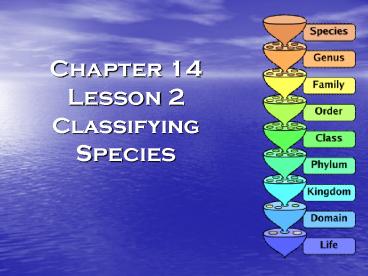Chapter 14 Lesson 2 Classifying Species PowerPoint PPT Presentation
1 / 22
Title: Chapter 14 Lesson 2 Classifying Species
1
Chapter 14 Lesson 2Classifying Species
2
Classification
- grouping objects or organisms based on
similarities
3
- 1. Taxonomy the science of classifying
organism s - - similarities among organisms indicates that
they are somehow related - 2. What categories are used to classify
organisms? - a. Homologies similar structures or similar
biochemistry that results from a common ancestor - b. Embryonic development development of fetus
- c. Genetics DNA and gene similarities
- d. Evolutionary history
4
History of Classification Systems
- 1. Aristotle - 350 BC
- a. Developed the 1st widely accepted
classification system - b. Divided organisms into plants or animals
- c. Plants were further divided by size and
structure (trees, shrubs, herbs) - d. Animals were classified by where they lived
(land, sea, or air)
5
Early Classification
- Previous classification system 2 kingdom
Plantae and Animalia - Declared inadequate
- Next system added
- Protista - microorganisms and bacteria
- Fungi mushrooms, molds, and yeasts
6
Carolus Linneaus
- Classification system based on physical and
structural similarities of organisms - b. System called Binomial nomenclature two
word names - i. 1st part Genus
- ii. 2nd part Species
- c. Latin
- d. Ex. Humans Homo sapiens
- e. Scientific names must be in italics or
underlined - f. Genus name is capitalized, species name is
lower case
7
Scientific Names
- i. common names can be misleading because they
vary (language or location) - ii. scientific names are recognized worldwide
- iii. scientific names indicate relationships
- 1. Maple Trees Genus Acer
- 2. Acer rubrum red maple
- 3. Acer saccharum sugar maple
8
Classification Groups
- Taxon a group of organism (plural taxa)
- Seven Classification Taxa
- 1. Kingdom largest taxa, includes many types
of organism with some similarities - 2. Phylum
- 3. Class
- 4. Order
- 5. Family
- 6. Genus
- 7. Species smallest category, only includes
one type of organism
9
- Similar species grouped in one Genus
- Similar Genus are grouped in one family so on
- Categories always based on similarities among
organisms - Ex. Phylum Chordata backbones
- Class Mammal warm-blooded, hair or fur, produce
milk for young - Order Carnivore - sharp teeth, claws, hunt and
eat meat - As we learn more, the classification of an
organism can change - Species a group of organisms that can mate and
produce fertile young
10
Six Kingdoms
- Differ in cell structure
- o Unicellular vs. multicellular
- o Prokaryotic vs. Eukaryotic
- Differ in means of obtaining energy
- autotrophic vs. heterotrophic
11
3. Protista (protists)
- a. Eukaryotic
- b. Single celled (but some, like algae, are
multicellular) - c. Most are microscopic
- d. Do not have complex organ systems
- e. 2 main divisions
- 1. Algae autotrophic
- a. Plant-like, but do not have leaves or
stems - b. Important base of many food chains
- 2. Protozoa heterotrophic
- a. Animal-like
- b. Amoeba, paramecium
12
(No Transcript)
13
4. Fungi
- a. Eukaryotes
- b. Unicellular (yeasts) and multicellular
(mushrooms and molds) - c. Heterotrophic mainly decomposers
- d. Cell walls contain chitin a long-chain
polymer of beta-glucose that forms a hard,
semitransparent material - e. Absorb food through cell walls
- f. Develop from spores, do not move
14
(No Transcript)
15
(No Transcript)
16
5. Plantea (Plants)
- a. Eukaryotic
- b. Multicellular
- c. Autotrophic (photosynthetic)
- d. Cell walls contain cellulose
- e. Tissues, organs, organs systems
- f. Do not move around
- g. Trees, moss, ferns, grass
17
(No Transcript)
18
6. Animalia (animals)
- a. Eukaryotic
- b. Multicellular
- c. Heterotrophic
- d. Able to move at some time in life
- e. No cell walls
- f. Tissues, organs, organ systems Ex. Nervous,
circulatory, muscle systems - g. Ex. Hydra, sponges, coral, fish, insects,
birds, frogs, mammals
19
(No Transcript)
20
Biological Keys
- also called dichotomous (2 branched) key
- series of paired (2) statements that compare or
describe characteristics of organisms in order to
identify them - To use a key you always start with the first set
of sentences, read the description, compare it to
your organism, then follow the instructions to
continue the key - You will work to find the name through
descriptions until the name of your organism is
given
21
How to make a dichotomous key
- divide your samples into 2 groups using one
characteristic - write a set of 2 sentences describing the
characteristics you have used to divide your
object/organisms - Characteristics must be objective (ex. 5 cm) not
subjective (ex. Short/long)
22
- Example
- 1.Has straight sidesgo to 2
- Does not have straight sides.go to 4
- 2. Has 3 sides triangle
- Has more than three sidesgo to 3
- 3. Has 4 sides ..Square
- Has more than 4 sides ..star
- 4.Diameter is same all over.circle
- Diameter varies.oval

